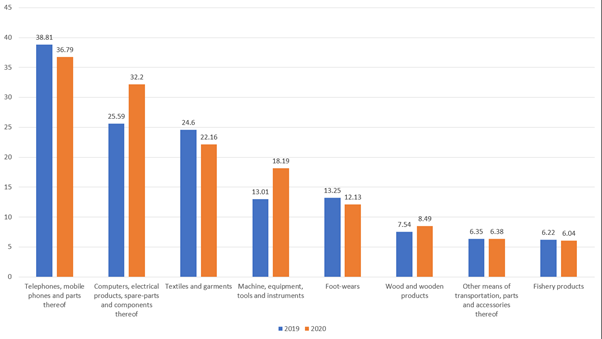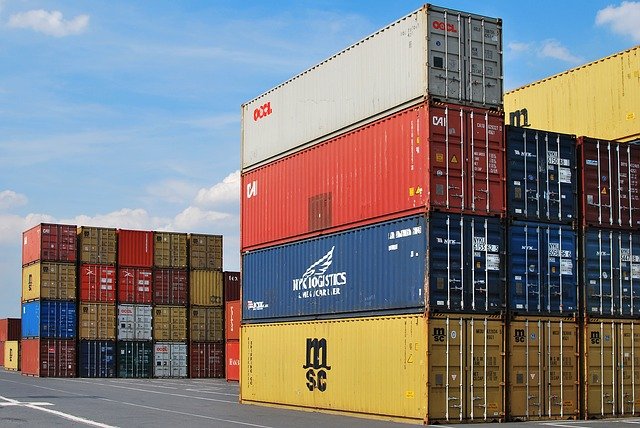Sourcing goods from Vietnam is not something too strange for foreign companies nowadays due to the fact that this country has emerged as an Asia potential manufacturing hub in recent years. However, this process is not without its difficulties. In fact, it requires lots of efforts and deep knowledge to be successfully completed. For this reason, this blog post aims to provide you with a general view of steps to source from Vietnam.
Go through the 6-step sourcing process below to know how to source goods from Vietnam as efficiently as possible.
Step 1: Product & Supplier analysis
When sourcing goods from Vietnam, the very first practice you have to perform is identifying products that you want to import from Vietnam. In fact, not all goods are produced in Vietnam. But if they are, good news is that your merchandise is going to be cheaper or have higher quality.
In this case, the chart of Top 8 Vietnam’s Exports in 2019 and 2002 could be a valuable source for your analysis. These products are exported to countries that have very high standards in importing goods.

Top 8 major exported commodities of Vietnam in the first 3 quarters of 2019 and 2020 (USD billion). Source: Vietnam Customs
In fact, according to the United States Trade Representative, Vietnam was the US’s 7th largest supplier of goods, with $66.6 billion of goods exports in 2019. The top import goods were electrical machinery, knit apparel, furniture and footwear. Besides, in the Vietnam Customs report, Vietnam exported telephones, textiles and garments, computers, agricultural products to 28 countries of the EU in the first 3 quarters of 2020.
After identifying the product you want to import, finding a supplier that offers you the best price is absolutely necessary. There are many platforms for you to fast check suppliers. Some good examples are Alibaba and Amazon, which provide you with a variety of Vietnamese suppliers. You can consider the various suppliers and their prices there.
In this step you should create a short list of 3-5 appropriate suppliers and contact them for more information. In order to find suitable suppliers for your merchandise, you can ask these suppliers 5 questions below and identify whether they are the good ones or not.
- Are you dealing with a manufacturer or a trading company?
- How long have they been in business and which countries have they exported to?
- What is the minimum order quantity they accept?
- Do they obtain any certifications for their products?
- How do they manage the logistics process?
Step 2: Quotation
Costs always have a considerable impact on choosing suppliers for your sourcing needs. After choosing a number of suitable suppliers, you should contact them to ask for a quotation. Quotation is a document that includes proposed prices for the suppliers’ goods. In detail, this quotation could include main factors below:
- Cost
- Minimum Order Quantity
- Unit Price
- Shipping terms
- Product description
In this step, you can directly negotiate with suppliers in order to achieve the best price for your sourcing. However, this step could be difficult for some companies if they do not have any staff who can handle language barriers. For this issue, it is highly recommended that you should have a Vietnamese speaker in the team to make your negotiation as detailed and effective as possible.
After considering some quotations, you now know which suppliers are suitable for your business. It’s time to book a flight to Vietnam and carry out manufacturers’ inspection.
Step 3: Pre-production Inspection
A full inspection for manufacturer’s capability is definitely essential before producing your goods. Most of Vietnam’s industrial zones concentrated in the Northern and Southern area. In fact, it would be convenient and save your time if you chose suppliers that are located in one region to pay a visit.
Additionally, you should keep information of other suppliers that also meet your requirements as a backup. If this supplier is not as good as you expected, you can quickly move to another one and complete this step in a suitable amount of time.
Nevertheless, even when you have inspected all manufacturers, it is still hard for you to make a decision. Due to the fact that you are doing business overseas, you cannot approach all the news and the performance of chosen suppliers in these years. And first impressions can somehow mislead you about the capability of a supplier. Therefore, it would be better if you have support from a Vietnamese expert, or someone who has long experience with this country.
Step 4: Sample Evaluation and Order
There are 2 main reasons for why this step is considered as an important one in sourcing goods. Firstly, evaluating the sample can ensure your products are going to be produced in a proper way and exactly meet your requirements. Secondly, if you are going to produce customized goods, this sample you approve could be used for comparing to the final products.
In this step, you can require suppliers to send their products’ to your business and pay for shipping costs or you can directly go to the manufacturers yourself to evaluate them. Nevertheless, the problem is that you do not have enough time to travel for each stage of the process. Furthermore, even if you order samples from your short list of ideal suppliers, it will get costly as you have to pay for each ship.
In order to avoid this cost, you can negotiate with the supplier and suggest that this payment should be taken off since the purchase order is large enough. Another solution is that you can ask your suppliers to send their samples to a third party located in the same country with your suppliers. This approach will help you save lots of money if you request samples from a list of suppliers.
After having enough information about the supplier’s capability and its product’s quality, now you can place an order with your most suitable supplier. However, in order to successfully complete this sourcing process, you still need to carefully consider the following steps.
Step 5: Inspections in Production Process and before Shipping
There are many issues that could be raised during the process of production as well as before your freight is shipped. In order to avoid these problems, a regular inspection is highly recommended. However, keeping an eye on the production process the whole time is nearly impossible when you are overseas. In this case, you could ask a third party located in Vietnam to inspect and report to you.
Besides, Pre-shipment inspection is also of great importance. The purpose of this step is to make sure that:
- The quantity and quality are right
- There is no defect in ordered products
- The packaging meets standards and goods can be safely transported
Furthermore, this practice can help you avoid any bad situation after your freight lands on the final destination. For example, when you do not take this step into account, there is a high chance that it will cost you a lot of time and cost for renegotiating and flying to deal with the manufacturer about defects in products.
Step 6: International Shipping
If you are not familiar with export/import procedure, international shipping could be a hard challenge for your business. This shipping process requires many documents as well as procedures to complete. Besides, choosing the transport method for your merchandise is also extremely important since it directly affects your products.
In terms of Transportation, there are three transport methods which are most used in Vietnam, including Air Freight, Sea Freight and Overland (by Truck or Rail). Each one has its own upsides and downsides. Therefore, in order to choose the right method for your freight, you have to take time to consider a number of key elements which have an impact on your dispatch.
Check out some methods and guidelines for international shipping at Sourcing from Vietnam: An Ultimate Guide to International Shipping
Regarding Shipping documents, adequately preparing these documents will smooth your international process, which means that you can save your time as well as avoid any delays in the shipping process. In particular, required documents for international transport include Commercial invoice, Bill of Lading, Letter of Credit and so on. Nevertheless, since this procedure is relatively complicated, it is difficult for businesses who do not have much experience in this field to handle all the documents.
Now, you have just gone through the full process for sourcing goods from Vietnam with 6 important steps. Despite the fact that this sourcing process is not without its challenges in each step, finding a right sourcing partner could be an optimal solution for your business. Not only does a sourcing company help you overcome language barriers in negotiation, it also supports you in preparing necessary documents for your shipping, which absolutely optimize your process of sourcing goods from Vietnam.
Viego Global – Your trusted sourcing partner in Vietnam
Are you going to source commodities from Vietnam, an Asia sourcing hub with great potential? Are you faced with any problems when sourcing from Vietnam? With professional experience and presence at factory location, Viego Global thoroughly understands and has the capability to help you break through all the barriers as well as successfully do business in this country. Just leave your comment below or click HERE for further support!

